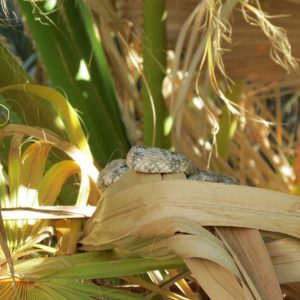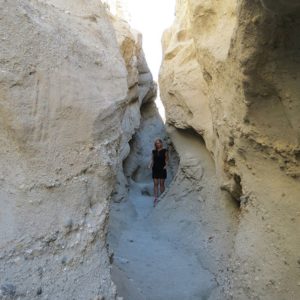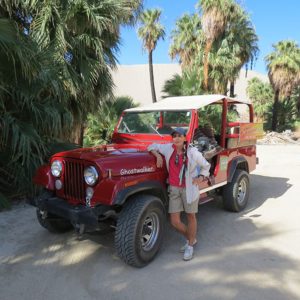Around the World
Palm Springs – More Than Vintage Cars and Movie Stars
Nov 2022 | By Pat Brennan
A subscription to National Geographic will help explain the San Andreas Fault, or you can take a ride in Ghostwalker.
Ghostwalker is what the Cahuilla people call the mountain lions that share their desert domain in Southern California. It’s also what Morgan Levine calls the little red Jeep she has been driving for 34 years around the desert canyons of the San Andreas Fault. You’ll learn a lot more about our dynamic earth by riding in Ghostwalker than you will from the magazine subscription. For one thing, you’ll rarely find humour in National Geographic, but there’s plenty of it in the bouncing Jeep.
A magazine won’t point out rattlesnakes curled up on a palm tree branch at eye level as you walk towards the fault. There’s nothing like the advice, “Just step where I step,” to keep you hanging on every word uttered by Levine – or Captain Morgan, as our passenger load dubbed her.
 We were five travel writers from downtown Toronto and Vancouver and we rarely needed to watch for rattlesnakes on our strolls, but it’s an everyday thing for Levine. “Yesterday, I saw four of them,” she mentioned casually, as if explaining the difference between sedimentary and igneous rock. We encountered two rattlers on our 100-metre stroll between the Jeep and the fault. Levine spotted them only two feet from her feet, although one was at eye level in a palm bush trying to get away from the hot, hot ground.
We were five travel writers from downtown Toronto and Vancouver and we rarely needed to watch for rattlesnakes on our strolls, but it’s an everyday thing for Levine. “Yesterday, I saw four of them,” she mentioned casually, as if explaining the difference between sedimentary and igneous rock. We encountered two rattlers on our 100-metre stroll between the Jeep and the fault. Levine spotted them only two feet from her feet, although one was at eye level in a palm bush trying to get away from the hot, hot ground.
She brings a lot of school kids out into the desert to explain Mother Earth. Keeping them in her footsteps must be a chore. Levine assured us rattlesnakes are not aggressive, but they seem to like biting white males aged 18-to-34 who have been drinking; mostly on their hands.
When she first started bringing school kids out to the fault 34 years ago, she would take photos of them standing with one foot on the Pacific Plate and one foot on the North American Plate. She can’t do that today. The gap between the plates is now 18 metres.
 Earthquakes and floods have widened the gap. There are floods out here on the barren desert known as the Coachella Valley because the flotsam and jetsam soil thrown up by the massive tectonic plates rubbing against each other don’t absorb water. So when it rains or mountain snow melts in the spring, the water cuts deep, narrow canyons in the desert soil.
Earthquakes and floods have widened the gap. There are floods out here on the barren desert known as the Coachella Valley because the flotsam and jetsam soil thrown up by the massive tectonic plates rubbing against each other don’t absorb water. So when it rains or mountain snow melts in the spring, the water cuts deep, narrow canyons in the desert soil.
You can hike into these box canyons by turning your body sideways at some points, if you don’t suffer from claustrophobia.
Levine explains how the canyon walls are actually history texts and calendars for geologists. Each major flood leaves lots of hard rocks embedded in the soft rocks of the desert floor and earthquakes leave skid marks, like the rubber deposited on a highway before a collision.
Because she has such incredible knowledge about the flora, fauna and wildlife of the Coachella desert, you would assume Levine has a graduate degree in geology or biology. “Nope,” she says. “After grade nine I just went and got a library card.”
Some of the things you’ll learn from Levine is how the Cahuilla people survive out here in Coachella with its 49°C (120°F) summer heat, prowling panthers, snakes galore, inquisitive coyotes and hidden water. She can show you how to make a straight, strong arrow with a poisoned tip from a simple twig.
She’ll explain why there is a gathering of date palm trees standing off to your right – blame the coyotes. They like to eat dates and then they poop out the pits after roaming miles from the original date palm.
The valley was 41°C (105°F) in early October, but with no humidity. It felt like 30°C (86°F). It is surrounded by mountain ranges soaring three kilometres into the sky and still rising. Levine said the colliding tectonic plates are pushing the mountains higher, faster than the wind and rain and earthquakes can erode them.
Desert Adventures is the Palm Springs touring firm that owns Levine’s red Jeep and a dozen others. If you have been driving with them long enough, they let you name your own Jeep – thus Ghostwalker.
 Levine is part Cahuilla and her Ivia (the Cahuilla language) name means ‘wing in hair.’ The long braid down her back was intertwined with colourful cloth.
Levine is part Cahuilla and her Ivia (the Cahuilla language) name means ‘wing in hair.’ The long braid down her back was intertwined with colourful cloth.
Desert Adventures has permission to roam its red Jeeps around the privately-owned, 1,000-acre Wilhelm’s Metate Ranch, which has been in the Wilhelm family since 1909. The Cahuilla have been living in the desert for 3,000 years and you’ll sometimes find their ancient history carved into the canyon walls.
To escape the summer heat of the desert, the Cahuilla moved higher into the mountains. You too can beat the heat by visiting Mount San Jacinto State Park, which is near the top of the three-kilometre mountain of the same name.
 The Cahuilla walked up, even though Mount San Jacinto has the sheerest mountain face in North America. You may find it easier to ride up the Palm Springs Aerial Tramway, the third longest in the world. The floors in the tramway’s two gondolas revolve 360 degrees twice during the 12.5-minute ride to the top, so you’ll get a full panoramic tour. The operator explains you are moving through five climatic zones – the equivalent of going from Mexico’s Chihauhaun Desert to the Canadian Arctic. When it is 41°C (105°F) at the base of the tramway, it is 21°C (70°F) at the top.
The Cahuilla walked up, even though Mount San Jacinto has the sheerest mountain face in North America. You may find it easier to ride up the Palm Springs Aerial Tramway, the third longest in the world. The floors in the tramway’s two gondolas revolve 360 degrees twice during the 12.5-minute ride to the top, so you’ll get a full panoramic tour. The operator explains you are moving through five climatic zones – the equivalent of going from Mexico’s Chihauhaun Desert to the Canadian Arctic. When it is 41°C (105°F) at the base of the tramway, it is 21°C (70°F) at the top.

